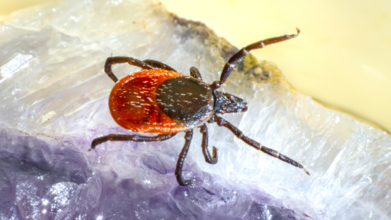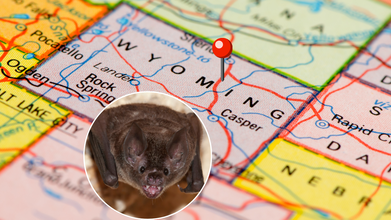- Health Conditions A-Z
- Health & Wellness
- Nutrition
- Fitness
- Health News
- Ayurveda
- Videos
- Medicine A-Z
- Parenting
- Web Stories
The Endometriosis Battle Finally Comes To An End For Bindi Irwin, As She Undergoes Removal Of 51 Lesions, Cyst, And Appendix

Credits: Instagram and Canva
A Lifelong Battle With Endometriosis: In a heartfelt post, shared on Instagram, Bindi Irwin, daughter of 'Crocodile Hunter', Steve Irwin shared a health update where she wrote about her journey of battling with endometriosis. She wrote that after 13 years of "fighting for answers", she is finally healing.
Her post revealed that she had to undergo a total of removal of 41 endometriosis lesions, a chocolate cyst, her appendix, and repair of a hernia from childbirth.
She wrote: "51 endometriosis lesions, a cyst, and my appendix were all removed across two surgeries with @seckinmd. My hernia from giving birth that was unzipping – was taken care of. I can FINALLY say that I’m feeling better. Genuinely healing.”
ALSO READ: Why Do We Know So Little About Women's Health?
Battling Endometriosis
A conservationist herself, inspired by her father, shared that she felt ashamed as a teenager and young adult when she had to speak about the painful endometriosis symptoms she suffered. Her message was: No young woman should feel ashamed or alone with pain that is too often dismissed as "just part of being a woman".
She revealed her diagnosis in March 2023 on social media. Since then, she has highlighted about this condition, which affects millions worldwide. In her recovery and healing journey Dr Tamer Seckin, an endometriosis specialist played a prominent role, who removed the 51 lesions during two separate surgeries, reported Fox News.
What Is Endometriosis?
As per the World Health Organization (WHO), endometriosis affects roughly 10%, which estimates to 190 million of reproductive age women and girls globally. In US alone, it impacts around 9 million women.
The Journal of the American Medical Association notes that diagnosis is often delayed and it averages from 5 to 12 years after the onset of symptoms due to the stigma and misdiagnosis. Often dismissing the pain as part of being a girl.
WHO notes that endometriosis is a disease in which tissue similar to the lining of the uterus grows outside the uterus. It can cause severe pain in the pelvis and make it harder to get pregnant. The symptoms can start at menarche and last until menopause.
The cause of endometriosis is unknown, and the WHO also notes that there is no way to prevent it or no cure available. However, the symptoms can be treated with medicines, and in severe cases, surgery may be required.
In case of a chocolate cyst, which was the case with Bindi Irwin, the ovarian cyst is filled with a thick, dark, tar-like fluid, which resembles melted chocolate. This fluid is old blood and endometrial tissue, which has accumulated due to endometriosis.
What Are The Common Symptoms Of Endometriosis?
The common symptoms include:
- Severe pain in the pelvis, especially during menstruation
- Pain during sex
- Pain while using the bathroom
- Infertility issues
However, some people with endometriosis may not have any symptoms, however, they feel pain in the lower part of the belly, this is where pain is most noticeable.
Other symptoms include:
- Chronic pelvic pain
- Heavy bleeding during periods or between periods
- Trouble getting pregnant
- Nausea or bloating
- Fatigue
- Depression and anxiety
Iowa-based Pharmacy Faces Charges For Selling Counterfeit Ozempic

Credits: Canva
Ozempic Lawsuit: For any medication that gains a popular status, there is a counterfeit available in the market. Similar happened with Ozempic, a popular diabetes and weight-loss drug, as a result, an Iowa pharmacy company, which is already involved in multi-million dollar lawsuit is now facing additional sanctions for distributing counterfeit Ozempic.
The Iowa Board of Pharmacy announced disciplinary actions against SmartScripts.
Did The Pharmacy Intentionally Sell Counterfeit Ozempic?
As per the reports, the timeline could be dated back to November 2023, when SmartScirpts placed an order with wholesale supplier Pharma Pac for a single case of Ozempic, which would contain 1,260 Ozempic pens. Each pen was designed to administer 4 milligrams of medications.
The problem arose when SmartScripts received 15 cases of medications, instead of a single one, ordered initially. Todd Thompson, who is the company owner went to ship the excess inventory to Central Pharma Management in Lansing, Michigan, which distributed the product among different pharmacies.
While all this seems too simple, the problem arose when Pharma Pac contacted Thompson for payment of the 15 cases.
Thompson's response to this was: quarantining the remaining Ozempic and advising the recipient pharmacies to halt the sales of the products.
Though there was no such reason mentioned in the regulatory documents for any such precautionary measures. So, why did Thompson asked the companies to put the sales on hold? The question arises: did he know that the Ozempic was a counterfeit product?
ALSO READ: This Naturally Occurring Molecule May Have Ozempic-like Benefits Without The Side Effects
Reporting Counterfeit Products
As per reports and state regulators, Thompson became aware about the counterfeit Ozempic on December 21, 2023, however, he did not notify the Iowa Board of Pharmacy until July 2024. This delayed reporting played a prominent role when disciplinary charges were filed against SmartScripts in January 2025.
Thompson, however, claims that he learned about the counterfeit drugs only after he had received a notification from the Food and Drug Administration (FDA) after he sold the products to Central Pharmacy Management. According to him, immediate action was taken to contact the purchasing pharmacy. He says that instead of being a participant in fraudulent activities, his company is among those over 100 pharmacies nationwide that fell victim to similar drug counterfeit schemes.
What Happens When You Consume Counterfeit Ozempic?
FDA on April 14, 2025, released an advisory against counterfeit Ozempic. The advisory reads:
"FDA was notified by Novo Nordisk on April 3, 2025, that several hundred units of counterfeit Ozempic (semaglutide) injection 1mg were in the U.S. drug supply chain. The counterfeit products were distributed outside the Novo Nordisk authorized supply chain in the U.S. FDA seized the identified counterfeit products on April 9, 2025.
The agency advises patients, wholesalers, retail pharmacies and health care professionals to check the Ozempic products they have received and not use, distribute or sell products labeled with lot number PAR0362 and serial number starting with the first eight digits 51746517."
Invasive New Tick Species Could Spread Little-Known Infectious Disease, Scientists Warn

Credits: Canva
A highly invasive tick species is spreading across the United States, carrying with it a previously unknown but potentially crippling infection that is causing scientists concern. First identified in New Jersey in 2017, the Asian longhorned tick has been detected in at least 21 states. With rising temperatures extending tick season and broadening their habitat, scientists fear that these invasive parasites may catalyze the spread of ehrlichiosis, a bacterial infection that is already increasing in the U.S.
Americans have linked ticks for decades with Lyme disease. But as climate change continues to reshape ecosystems and new invasive populations find a toehold, the risk landscape is evolving. Ehrlichiosis, previously rare, is now emerging as a major public health problem—and the experts say the risks are likely to increase.
Indigenous to East Asia, the Asian longhorned tick is an opportunistic species. It came to other nations such as Australia, New Zealand, and various Pacific islands before it arrived unobtrusively in the United States. Scientists speculate that it most likely rode in on imported animals or livestock, but their point of entry is not known.
Since its New Jersey discovery, the tick has consistently gained a foothold throughout the Northeast, Midwest, and South. Michigan had its first sighting during this summer, indicating how rapidly its range is spreading. Modeling research indicates that the majority of North America—southern Canada to almost every nook and cranny of the continental U.S.—poses acceptable habitat for this resilient species.
What's more frightening about the longhorned tick is that it can reproduce without mating. One female will produce thousands of offspring, which enables populations to increase quickly. Unlike most indigenous animals, this tick is also able to co-feed on the same host with other ticks and retrieve and pass along pathogens very efficiently.
What is Ehrlichiosis?
The tick-transmitted disease ehrlichiosis, caused by the bacterium Ehrlichia chaffeensis, has risen in the shadows of recent years. A bite produces its effects usually one to two weeks later, in the form of fever, chills, muscle pain, headaches, and crushing fatigue.
Though most of them recover with early treatment, the disease becomes life-threatening if neglected. In serious situations, it develops into respiratory failure, brain and nervous system injury, uncontrollable bleeding, or organ failure. Approximately 60% of patients need to be hospitalized, and about 1% die from the disease, as per the CDC.
Confirmed cases went from only 200 in 2000 to over 2,000 in 2019. Experts, however, believe these figures are merely the tip of the iceberg. Rutgers University studies indicate that as much as 99% of infection may go undetected or unreported, masked by nonspecific flu-like symptoms doctors may attribute to other explanations.
Is Climate Change Contributing To Tick-Borne Diseases?
The biology of ticks is closely coupled with the weather. In the past, long, frigid winters kept tick populations low, both in terms of their numbers and in terms of the diseases they were spreading. Climate change is rewriting that season script, though.
"We are losing winter," says Connecticut's tick-testing program director, Goudarz Molaei. "And this tick, like others, will be active year-round."
Warmer, shorter winters mean ticks come out of hibernation earlier and remain active for longer periods, raising the chances of human contact. The CDC just released word of an all-time high number of emergency room visits in July for tick bites—illustrating how rapidly the risks are increasing.
The longhorned tick is not coming alone. A study in iScience reported seven non-native tick species arriving in Connecticut during 2019-2023. They rode in on livestock, pets, or travelers and are potential carriers of domestic and exotic diseases.
Several of these ticks carried bacteria similar to those causing Rocky Mountain spotted fever, a lethal disease recently starting to appear in Connecticut even though it has been nonexistent there historically. Other invasive ticks are recognized carriers of Theileria orientalis, a cattle-decimating parasite not yet shown to pose danger to humans.
Worldwide, ticks spread over 17% of infectious diseases in humans, the World Health Organization finds. In the United States, they are responsible for 77% of all vector-borne illnesses, case loads more than doubling over the past 15 years. The introduction of invasive ticks merely increases the stakes.
Why Invasive Ticks Are Different?
In contrast to indigenous species, invasive ticks present two such significant threats: they increase the range of current diseases and bring with them the potential to introduce entirely new ones. With their explosive ability to breed and thrive in a variety of climates, longhorned ticks are particularly well-suited to redefine the U.S. disease map.
Their diet also distinguishes them. Though they usually prefer livestock, they will consume humans if given the chance. And when there is more than one tick species that feeds on a single animal, they can share pathogens with each other in what is called "co-feeding transmission," multiplying the chances of new disease dynamics.
How Ticks Spread Diseases?
Ticks are not born with pathogens. They pick them up after they feed on an infected animal like deer, rodents, or livestock. Ticks being infected have the ability to transmit the pathogen to the next host—occasionally human.
America has about 50 native tick species that will bite humans and transmit diseases such as Lyme disease, babesiosis, anaplasmosis, and Rocky Mountain spotted fever. Invasive ticks, however, expand that menu of potential harm by introducing pathogens from elsewhere in the world into American habitats.
Is There Any Way to Avoid Tick-Borne Disease?
As scientists track the spread of invasive ticks, members of the public can act to minimize individual risk. Long sleeves and long pants in tick-infested areas, repellents that have DEET or permethrin, and careful tick checks after going outside are the most effective measures.
Medical professionals also advise travelers to report recent travel when they go for medical attention for tick bites, as invasive ticks from other countries are often hard to distinguish from local ones. Prompt diagnosis and treatment of ehrlichiosis and other diseases can be the difference between life and death.
The outbreak of invasive ticks in the United States illustrates how global change, fueled by climate change, trade, and travel, reconfigures local health threats. Within a decade, a species foreign to most Americans is now a possible cause of a major public health epidemic. Experts predict it's only a matter of time before other invasive ticks catch local or native pathogens, or even create new ones not previously observed in the US.
Wyoming Health Officials Hunt for 200 Exposed Tourists After Bat-Infested Cabins Spark Rabies Scare

Credits: Health and me
Nearly 200 tourists are being traced by Wyoming health officials after bat-infested cabins at Grand Teton National Park sparked a rabies scare, raising urgent public health concerns. For some tourists who came for a trip to Wyoming’s Grand Teton National Park promises postcard-worthy mountains, pristine lakes, and wildlife encounters. But for hundreds of tourists this summer, the trip came with an unexpected and terrifying souvenir, possible rabies exposure.
State health officials are now urgently tracking down more than 200 people from 38 states and seven countries who may have been exposed to the near-always fatal virus after staying in bat-infested cabins at Jackson Lake Lodge.
Between May 15 and July 27, guests lodged in eight specific cabins—rooms 516 through 530—may have unknowingly slept just beneath a bat colony nesting in the attic. After multiple reports of bats flying into guest rooms, the lodge shut down those cabins on July 27. By then, more than 250 reservations had been fulfilled, meaning up to 500 guests could have rotated through the infested spaces.
Travis Riddell, director of the Teton County Public Health Department, explained that repeated sightings strongly suggest a colony, not isolated strays. “Although there were a lot of people exposed in this incident, one positive about it is that we know who 100 percent of those people are,” he said. That knowledge is crucial for officials working to prevent the spread of a disease that almost always turns fatal once symptoms appear.
What is Rabies?
Rabies is one of the deadliest viruses known to humans. Spread through the saliva of infected animals—typically bats, raccoons, skunks, and foxes—it attacks the nervous system, traveling to the brain where it causes swelling, neurological breakdown, and ultimately death. Once symptoms begin, the disease is virtually untreatable.
Dr. Alexia Harrist, Wyoming’s State Health Officer, emphasized that even the smallest bite or scratch can be dangerous. “Bats are the area’s most common host for rabies and their bite leaves such a small mark that it is rarely visible,” she explained. This is what makes cases like Jackson Lake Lodge so alarming: guests could have slept through a bat encounter without ever realizing it happened.
What Counts as Rabies Exposure?
Health officials categorize rabies risk based on contact. The highest concern is for those who:
- Were bitten or scratched by a bat
- Had bat saliva touch broken skin or mucous membranes
- Touched a bat directly
- Could not confirm exposure, such as children, deep sleepers, or individuals with impaired awareness
Not every guest will require the post-exposure prophylaxis vaccine, but because the stakes are life and death, officials are urging caution.
Rabies Vaccine And Its Cost
Rabies is preventable if treatment starts quickly. A regimen of immune globulin plus a four-to-five dose vaccine series given over two weeks is almost 100 percent effective at preventing the virus from taking hold.
The treatment is expensive and sometimes difficult to access. In Wyoming, a single course can cost up to $16,000 per person, with some hospitals charging double that amount. Multiply that by hundreds of potentially exposed tourists, and the financial toll could be staggering.
Yet health officials stress that money should not deter people from seeking care. As Dr. Harrist put it, “The death of one person because of something that we could have otherwise prevented is not acceptable.”
Is US Awaiting A New Health Crisis?
Though the dog-specific rabies variant was eliminated in the U.S. in 2007 thanks to vaccination laws, rabies remains firmly entrenched in wildlife populations. Bats, raccoons, skunks, and foxes are the primary reservoirs, and each summer, local health departments from Maine to California field calls about possible exposures.
In fact, within just the past month, counties across multiple states—including North Carolina—have reported rabies-positive animals and urged residents to stay alert. In one North Carolina case, a fox attacked a young mother outside her home, biting her leg and hand. Both she and another victim are receiving treatment.
These incidents illustrate a troubling trend: while human rabies cases remain rare in the U.S. (usually one to three per year), wildlife exposures are rising, especially during summer when both humans and bats are most active.
Mass exposure events are rare, but not unheard of. The last time Teton County saw something similar was in 2017, when a bat colony discovered at AMK Ranch led to over a dozen people receiving treatment.
This year’s case, however, is on a much larger scale. The fact that officials must now coordinate across nearly 40 states and multiple countries underscores how modern travel can turn a local outbreak into a global health concern. The U.S. Centers for Disease Control and Prevention (CDC) has been brought in to help track down foreign visitors who stayed at the lodge.
For Wyoming health authorities, the challenge is two-fold: alerting potentially exposed individuals without causing unnecessary panic. Officials stress that people who did not stay in the affected cabins—or who stayed elsewhere at the lodge—face no risk. The lodge itself has taken aggressive steps to secure the area, and other parts of the property remain open, including as host venue for the high-profile Jackson Hole Economic Policy Symposium.
Emily Curren, Wyoming’s public health veterinarian, praised the lodge company for swift action. “They’ve done a fantastic job of doing their due diligence to make sure everyone coming in is going to be as safe as possible,” she said.
What Tourists Should Know About Bat Encounters?
Bats are an essential part of many ecosystems, eating insects and pollinating plants. But they are also the leading source of rabies in the U.S. Signs of rabid bats include flying during the day, erratic circling, or being unable to fly at all. Anyone who finds a bat indoors should avoid direct contact and call local animal control or health authorities immediately.
The Wyoming rabies scare is a stark reminder that while rare, rabies is not a relic of the past. It’s still out there, carried silently by wildlife and capable of turning a family vacation into a medical emergency.
© 2024 Bennett, Coleman & Company Limited

